The History of Graphic Art and the Stages of its Development
DOI:
https://doi.org/10.26577/HJ.2019.v52.i2.014Keywords:
rock graphics, graphic perception, petroglyphs, graphic works, graphics.Abstract
This article analyzes the theoretical concepts of graphic art and its types, the history of early human unification, graphic art on the territory of Kazakhstan. Throughout the history of the survey, it is aimed at studying the appearance of graphics, studying and familiarizing with its various methods. Therefore, artistic graphics are closely related to calligraphy and writing. By the nineteenth century, the concepts of graphic and pattern were strictly differentiated. Graphics can be drawings of typographical origin, and drawing ‒ images of handwork: sketches, options and much more.
The article deals with the laws of development of applied graphics from ancient prehistoric times to the present day. You can see the meaning of drawings, sketches and drawings in a person’s life, the role they played in the development of humanity. The development of graphics from prehistoric times to the present is analyzed. Drawing is the basis of all types of graphics and visual arts, in general. Typically, a graphic image is performed on a sheet of paper, and to create it the artist can use rather simple means – a pencil or a ballpoint pen. In other cases, he uses complex tools for creating his works: a printing press, lithographic stones, lashes for linoleum or wood, and much more. Graphics has a long history. Artists from Western Europe, such as Leonardo da Vinci, Michelangelo, Rembrandt, Orest Kiprensky,
Karl Bryulekov, Vasily Perov, Ilya Repin, enrich the world of fine art with their graphic works. Graphic illustrations of the ancient (Paleolithic) era in Kazakhstan include Balkhash, Turkestan, Mangistau, and others. There are also rock paintings on the ground. Modern Kazakh graphic art was formed between 1930 and 50 years.
References
Arhıtektýra, grafýka ý dekoratývno-prýkladnoe ýskýsstvo s drevneıshıh vremen do epohı Vozrojdenııa. Entsıklopedııa [Architecture,
graphic and arts and crafts since the most ancient times to Renaissance. Encyclopedia] «Avanta +» (t.7). M., 2000. 688 b.
Asylhanov E.S. Naýchno-metodıcheskoe obosnovanıe obýchenııa ızobrazıtelnomý ıskýsstvý ı razvıtııa tvorcheskıh sposobnosteı
ýchaıhsıa shkol ı stýdentov vysshıh hýdojestvenno-pedagogıcheskıh ýchebnyh zavedenıı Kazahstana [Scientific and methodological
substantiation of teaching fine arts and the development of creative abilities of pupils of schools and students of higher artistic and
pedagogical educational institutions of Kazakhstan] Dıs. ... d– ra ped. naýk: 13.00.02. ‒ Ýst-Kamenogorsk, 2002. ‒ 472 c.
Aýezov M.M. Shelkovyı pýt kak magıstral geoınformatsıı: dýh, opyt, tradıtsıı ı sovremennost [The Silk Way as a highway of
geo information: spirit, experience, traditions and modernity] // Bıblıotekove¬denıe. Bıblıografııa. Knıgovedenıe: Sb. st. ‒ Vyp.
«Knıga ı Velıkıı shelkovyı pýt»: Materıaly mejdýnar. konf.— Shymkent, 14-16 noıabrıa 2007 g. ‒ Almaty, 2008. ‒ S. 13.
Baıpakov K.M. Po sledam drevnıh gorodov Kazahstana: (Otrarskıı oazıs). [In the footsteps of the ancient cities of Kazakhstan:
(Otrar oasis). ] ‒ Almaty: Naýka,1990. ‒ 208
Bernal Dj. Naýka v ıstorıı obestva. [Science in the history of society] M .: Zarýbejnaıa lıteratýra, 1956 – 280
Borodın A.I., Býgaı A. S. Bıografıcheskıı slovar deıateleı v oblastı matematıkı: Per. s ýkr. / Pod red. I.I.Gıhmana. ‒ Kıev: Radıanska shk., 1979. ‒ 308.
Býrıakov Iý.F. Hrıstıanstvo na Velıkom shelkovom pýtı // Iz ıstorıı drevnıh kýltov Sredneı Azıı. Hrıstıanstvo.[ Christianity on
the Great Silk Road // From the history of ancient cults of Central Asia. Christianity ] ‒ Tashkent, 1994. ‒ 19-25.
Velıkıı shelkovyı pýt. Goroda, strany ı ıstorııa Shelkovogo pýtı. Shelkovyı pýt v ıstorıı Tsentralnoı Azıı. Karta Velıkogo shelkovogo
pýtı [The Great Silk Road. Cities, countries and history of the Silk Road. Silk Road in the history of Central Asia. Great Silk
Road Map] // orexca.com/rus/silkroad.html
Govorov Iý.L. Istorııa stran Azıı ı Afrıkı v srednıe veka. Relıgıozno-kýltýrnyı faktor v razvıtıı stran Vostoka [History of Asian
and African countries in the Middle Ages. Religious and cultural factors in the development of the countries of the East] // history.
kemsu.ru/oldversion/PUBLIC/govorov1/gov_0-0.htm.
Gýseva M. A., Smırnova L. P. Velıkıe preobrazovatelı estestvoznanııa: Leonardo da Vınchı: 27 XVIII mejdýnarodnyh chtenıı.
[Great converters of natural sciences: Leonardo da Vinci: 27 XVIII international readings] 20-21 noıabrıa 2002 g., Mınsk. I. F. Gabrýs.
Mn .: BGÝIR, 2002. 330 s.
Ivanıtskıı I.D. Hrıstıanskaıa sımvolıka v Sogde // Iz ıstorıı drevnıh kýltov Sredneı Azıı. Hrıstıanstvo. [Christian symbolism in
Sogd / / From the history of ancient cults of Central Asia. Christianity.]— Tashkent, 1994. ‒ 64-70.
Malahov V. A. Iskýsstvo ı mırootnoshenıe cheloveka. Kıev: Naýkova dýmka. [Art and human attitude. Kiev: Naukova Dumka] 1988.211
Matvıevskaıa G.P. Istorııa tochnyh naýk na srednevekovom Blıjnem ı Srednem Vostoke. [The history of exact sciences in the
medieval Near and Middle East] ‒ Tashkent: Fan, 1972. ‒ 248
Maınıcheva A.Iý. Problemy etnıchnostı ı samoıdentıfıkatsıı v rabotah zarýbejnyh avtorov: ıstorıografıcheskıı ocherk [Problems
of ethnicity and self-identification in the works of foreign authors: historiographical essay] // Sıbırskaıa zaımka: Naýchnaıa jızn. ‒
2004. ‒ № 1 //zaimka.ru.
Svarovskaıa V.P. Nekotorye metodologıcheskıe problemy vzaımodeıstvııa naýkı ı ıskýsstva. Metodologıcheskıe problemy
razvıtııa naýkı. [Some methodological problems of the interaction of science and art. Methodological problems of the development
of science] Novosıbırsk, 1984. Str. 129-146.
Solodovıchenko L.N. Istokı grafıcheskogo ıskýsstva ı stanovlenıe hýdojestvennogo obrazovanııa v Tsentralnom Kazahstane
[The origins of graphic art and the formation of art education in Central Kazakhstan ] // Jýrnal «Vestnık KarGÝ», 2011
Toktosýnova A.I. Tradıtsıonnaıa sıstema myshlenııa nomadov kak ıstochnık razvıtııa kochevoı kýltýry [The traditional thinking
system of nomads as a source of development of nomadic culture] // Tsentral¬naıa Azııa ı kýltýra mıra: Mejdýnar. naých.-obrazovat.
jýrn. ‒ 2006. ‒ № 1-2 (19-20).
Teılor E.B. Pervobytnaıa kýltýra [Primitive culture] . M., 1993. 37
Ýmarov A.A. Týranskıe pısmennostı ı knıjnoe delo v ınfrastrýktýre Velıkogo shelkovogo pýtı [Turanian writing and books in
the infrastructure of the Great Silk Road] / A.A. Ýmarov, E.A.Ahýndjanov // Kіtaphanataný. Bıblıografııa. Kіtaptaný: Sb. st. ‒ Vyp.
19. ‒ Almaty, 2008. ‒ 35-44.
Art education in the Republic of Kazakhstan: the perception of national traditions and the convergence of cultures: a scientific
article. Available in Kazakh, Russian and English. ‒ UNESCO Moscow Office, 2010; UNESCO Office in Almaty, 2010; Kazakhstan
National Federation of UNESCO Clubs, 2010. ‒ 64




